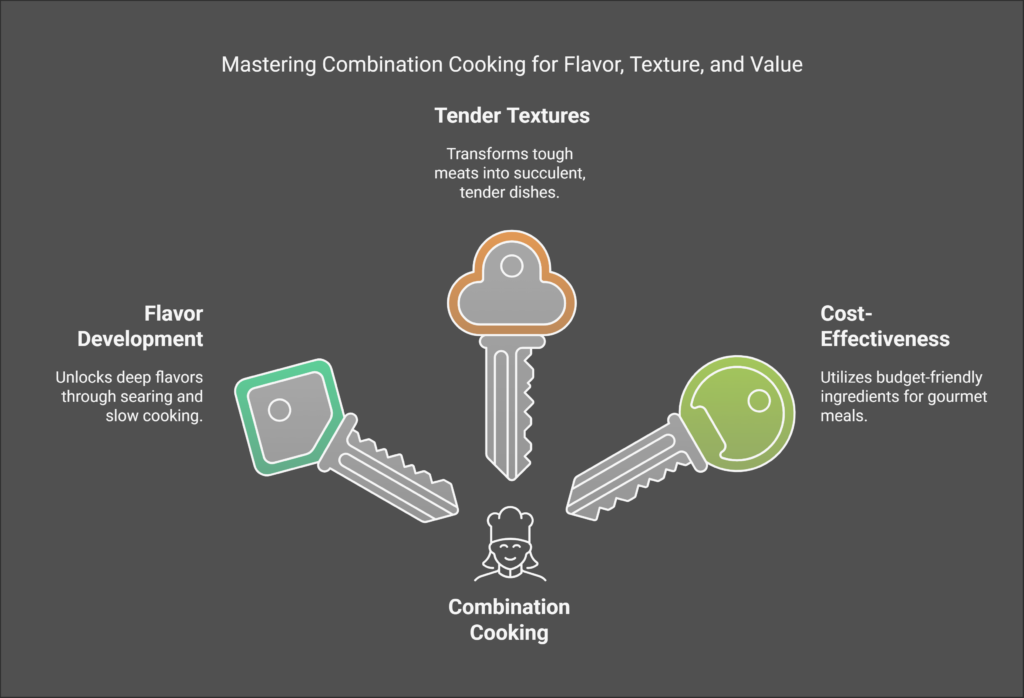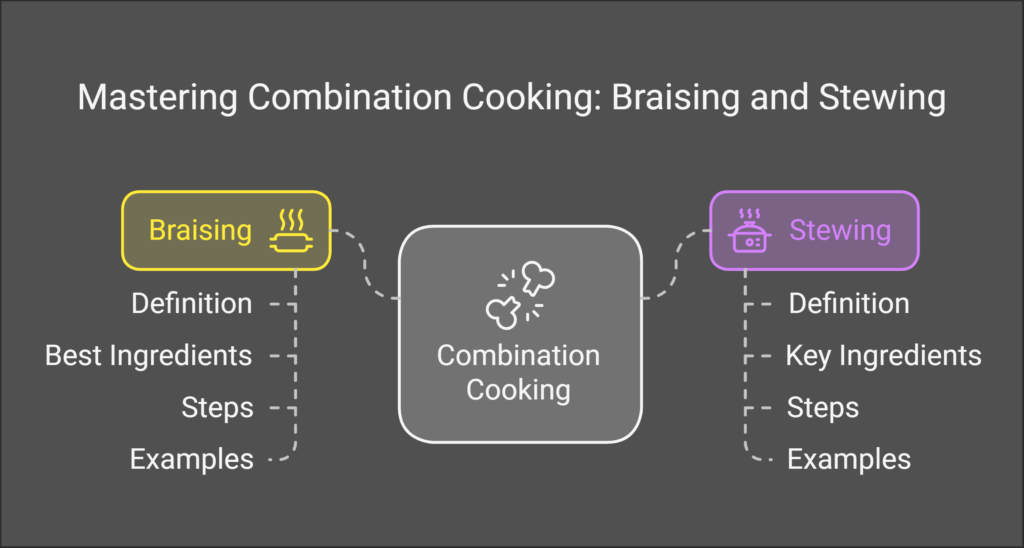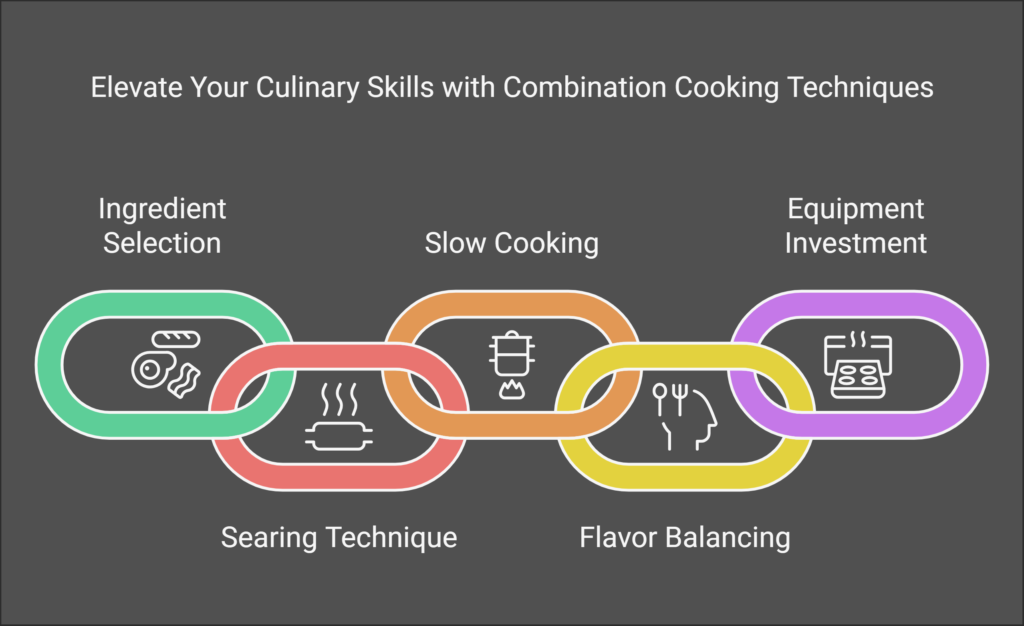Combination cooking is one of the most effective and versatile techniques every chef should master. It brings together the best of both worlds—incorporating both dry heat cooking and moist heat cooking methods to create dishes that are rich in flavor, perfectly tender, and deeply satisfying. This guide is built for both home chefs and professionals looking to bring their cooking to the next level.
Here, we’ll take a deep dive into the two foundational techniques of combination cooking—braising and stewing—and provide actionable tips to elevate your skills. Plus, we’ve included internal links to further tools and guides so you can fully explore these methods.
What is Combination Cooking?
To truly master combination cooking, we first need to understand what it is and what makes it unique.
1. Definition of Combination Cooking
Combination cooking is a method that uses both dry and moist heat to create complex flavors and tender textures. It starts with a technique like searing or browning (dry heat), followed by slow cooking in liquid (moist heat), giving the dish layers of richness and depth.
2. How it Combines Dry and Moist Heat
The process works in two phases. The initial dry heat, often achieved by searing meat or vegetables, helps caramelize the natural sugars, creating a deeper flavor profile. The second phase, where ingredients are cooked slowly in liquid, ensures they become moist, tender, and infused with complementary flavors.
3. Examples of Combination Cooking Dishes
Some classic examples of dishes made with combination cooking methods include beef bourguignon, coq au vin, ratatouille, and osso buco. These recipes are renowned for their rich flavors and melt-in-your-mouth textures, making them favorites across cuisines worldwide.
The Benefits of Combination Cooking
Why should you invest time into mastering combination cooking? The benefits speak for themselves.
1. Enhanced Flavor Development
The initial searing step caramelizes sugars and proteins in both meats and vegetables, unlocking a depth of flavor that’s further enriched during slow cooking.
2. Tender, Juicy Textures
Tough cuts of meat—such as brisket or pork shoulder—are transformed into succulent, fork-tender dishes through the low-and-slow moist cooking process.
3. Cost-Effective and Efficient
By focusing on tougher cuts and seasonal produce, combination cooking is a budget-friendly way to create gourmet-quality meals without expensive ingredients.

The Two Pillars of Combination Cooking: Braising and Stewing
Now that you understand the fundamentals, it’s time to focus on the two primary techniques of combination cooking—braising and stewing.
Braising and Stewing form the backbone of this cooking method, and mastering them will unlock a world of culinary possibilities. Below, we introduce these techniques with step-by-step guides tailored for your success.
Section 1. Braising
What is Braising?
Braising involves cooking large cuts of meat or whole vegetables by first searing them, then slowly cooking them in a small amount of liquid—such as stock or wine—over low heat. This allows the ingredients to soak up the liquid, transforming them into tender, flavorful masterpieces.
Best Ingredients for Braising
- Tough cuts of meat like pork shoulder, beef brisket, or lamb shanks.
- Hearty vegetables like carrots, potatoes, and turnips.
Steps for Successful Braising
- Searing: Start by browning the surface of your ingredients in a hot pan to develop that essential caramelized layer.
- Deglazing: Add liquid (such as wine or stock) to lift the delicious browned bits stuck to the pan—this is flavor gold!
- Slow Cooking: Cover and cook the ingredients over low heat, allowing the moisture and aromatics to develop over time.
Common Braised Dishes
- Coq au Vin (French wine-braised chicken).
- Osso Buco (Italian braised veal shanks).
- Braised cabbage or fennel for vegetable lovers.
“Complete Guide to Braising.”
Section 2. Stewing
What is Stewing?
Stewing, while similar to braising, is typically used for smaller, bite-sized pieces of meat and vegetables that are fully submerged in liquid. This technique produces dishes with a more soup-like or saucy consistency.
Key Ingredients and Equipment for Stewing
- Bite-sized cuts of beef, lamb, or chicken.
- Soft vegetables like zucchini, tomatoes, and bell peppers.
- Essential tools include a Dutch oven or a slow cooker.
Step-by-Step Guide for Delicious Stews
- Prep Ingredients: Cut ingredients into uniform pieces to ensure even cooking.
- Brown the Meat: Sear the meat in small batches for optimum caramelization.
- Build the Base: Sauté aromatics like onions, garlic, and spices.
- Add Liquid: Incorporate broth, wine, or tomatoes as your stewing liquid, along with herbs and seasonings.
- Simmer Low and Slow: Cover and cook until the meat and vegetables are tender.
Examples of Popular Stews
- Beef Stew (a hearty, umami-packed classic).
- Ratatouille (a French vegetable medley).
- Lamb Tagine (a Moroccan-inspired delight).

Tips for Mastering Combination Cooking
Use these pro tips to get the most out of your combination cooking adventures.
- Choose the Right Ingredients
Opt for tougher cuts of meat (like chuck roast or lamb shank) and hearty vegetables that can withstand slow cooking.
- Don’t Skip the Sear
This step sets the stage for flavor excellence by caramelizing the ingredients.
- Perfect the Slow Cooking Process
Maintain a low, steady heat. This ensures the ingredients cook evenly and remain melt-in-your-mouth tender.
- Balance Your Flavors
Adjust seasonings and tastes as you go. A splash of vinegar or a pinch of sugar can make all the difference.
- Invest in the Right Equipment
A sturdy Dutch oven, a slow cooker, or an Instant Pot can make all the difference in your combination cooking success.

How Combination Cooking Elevates Flavor and Texture
The Science of Flavor
Combination cooking unlocks complex flavor layers by searing ingredients first, followed by slow cooking that allows flavors to meld beautifully.
Moisture Retention Secrets
Moist heat keeps your ingredients tender and juicy throughout the process.
A Flavorful Transformation
Imagine a tough piece of chuck roast becoming a buttery, flavorful centerpiece for your Sunday dinner—this is the magic of combination cooking.
Common Mistakes to Avoid
To ensure your dishes come out perfect every time, steer clear of these pitfalls.
- Skipping the Searing Step
This results in dishes lacking depth and richness of flavor.
- Using the Wrong Ingredients
Examples include using lean meats that can dry out or delicate vegetables that might turn to mush.
- Overcooking or Undercooking
Too much heat or too little cooking time can ruin the texture of your final dish.
Final Thoughts
Mastering combination cooking through braising and stewing is a game-changer for any home cook or professional chef. These techniques unlock deep, complex flavors and transform even the toughest ingredients into tender, mouthwatering dishes. By following the steps outlined in this guide, you’ll elevate your cooking and create meals that impress every time.
Now it’s your turn! Have you tried braising or stewing before? Do you have a go-to recipe or a secret tip? Share your thoughts in the comments below!
🔥 Tag us @RoastedKitchen when you try these techniques and posted in your instagram—we’d love to see your creations!
If you found this guide helpful, don’t forget to share it with fellow food lovers and subscribe to our newsletter for more expert cooking tips, recipes, and in-depth guides. Let’s keep cooking together! 🍽️✨
Frequently Asked Questions (FAQ) About Combination Cooking
1. What is combination cooking?
Combination cooking is a method that uses both dry heat and moist heat to prepare dishes. First, food is seared or browned using dry heat to develop flavor through caramelization. Then, liquid is added, and the dish is cooked slowly using moist heat to create tender textures.
2. What are the two main techniques of combination cooking?
The two primary techniques are:
- Braising: Large cuts of meat or sturdy vegetables are partially submerged in a flavorful liquid and cooked slowly in a covered dish.
- Stewing: Smaller, bite-sized ingredients are fully submerged and simmered in liquid, resulting in a dish with a hearty, saucy consistency.
3. What are the benefits of combination cooking?
- Enhanced flavors due to the caramelization in the dry-heat phase.
- Tender textures from slow cooking in a moist environment.
- Cost-effectiveness by transforming affordable, tough cuts of meat into gourmet-quality meals.
4. What is the difference between braising and stewing?
- Braising uses larger cuts of meat or vegetables, with ingredients only partially submerged in liquid.
- Stewing involves smaller, uniform pieces of ingredients that are fully submerged, creating a broth or sauce with more liquid.
5. What are the best ingredients for combination cooking?
- Tough cuts of meat such as chuck roast, pork shoulder, or lamb shanks.
- Hearty vegetables like carrots, parsnips, potatoes, or fennel.
- Flavorful liquids like stock, wine, or coconut milk.
6. Do I need special equipment for braising or stewing?
While not mandatory, using the right tools can make a big difference. Ideal equipment includes:
- Dutch ovens
- Heavy-bottomed pots
- Slow cookers
These retain heat well and promote even cooking.
7. Why is searing important in combination cooking?
Searing builds layers of flavor by caramelizing the food’s surface, producing rich, savory notes that elevate the final dish. It’s a crucial first step not to skip.
8. What are common mistakes to avoid in combination cooking?
- Skipping the searing step: This sacrifices flavor.
- Using the wrong amount of liquid: Too much dilutes flavor; too little risks drying out ingredients.
- Rushing the process: High heat can ruin the texture. Slow cooking is key.
- Overstirring in stews, which can break down the ingredients.
9. How can I perfect my braising technique?
- Sear the food thoroughly to build flavor.
- Use a tight-fitting lid to trap moisture.
- Keep the heat low and cook for several hours for tenderness.
- Always use high-quality, complementary liquids like wine or broth.
10. How can I ensure my stew has the right consistency?
- Use adequate but not excessive liquid to submerge all ingredients.
- Thicken the stew using tomato paste, flour, or blended vegetables as needed.
- Stir gently and adjust the seasoning toward the end of cooking.
11. What should I do if my dish is too salty or bland?
- If too salty, add unsalted broth, potatoes, or a splash of acid (like lemon juice) to balance it.
- If bland, incorporate fresh herbs, spices, or a splash of vinegar near the end of cooking to enhance flavors.
12. Can I use combination cooking for vegetarian dishes?
Absolutely! Braising works wonders with hearty vegetables like cauliflower, fennel, and cabbage. Stewing is great for legumes, beans, and firm vegetables like potatoes or zucchini.
13. How can I save time without sacrificing flavor?
You can use a slow cooker or pressure cooker for combination cooking. These tools can replicate the slow-cooking process in less time while preserving flavor and texture.
14. What dishes are perfect examples of combination cooking?
- Braised short ribs
- Coq au vin
- Beef stew
- Ratatouille
- Osso buco
- Chicken and dumplings
15. What’s the biggest tip for mastering combination cooking?
Patience is key. Slow cooking at low temperatures allows flavors to develop fully and ensures the perfect tender texture for meats and vegetables. Trust the process, and you’ll be rewarded with gourmet-quality results!
Feel free to explore our detailed guides and recipes to start practicing combination cooking techniques today!

Hi, I’m Mayaz Ahsan!
As a passionate cook, storyteller, and food enthusiast, I combine my love for travel, farming, reading, and teaching to bring you insightful culinary tips and stories. Welcome to Roasted Kitchen – I’m thrilled to share this journey with you!










 Subscribe to our free newsletter for tips, tutorials, and insights!
Subscribe to our free newsletter for tips, tutorials, and insights!